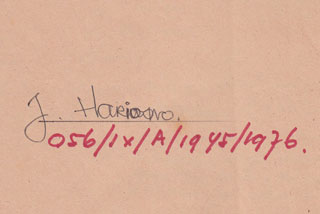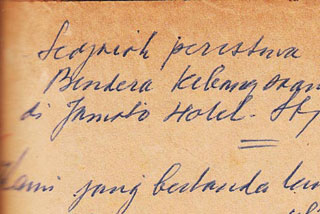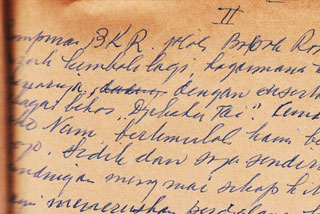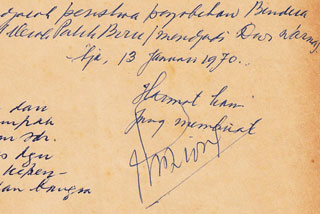Insiden Bendera
Dokumen: Kesaksian DHD 45
Daftar Kesaksian :
3. Kesaksian Hariono
Halaman 1
Halaman 2
Halaman 3
Halaman 4
Transkrip dan Translasi Kesaksian Hariono
![]() Transkrip Kesaksian Hariono
Transkrip Kesaksian Hariono
3 Halaman
![]() Translasi Kesaksian Hariono
Translasi Kesaksian Hariono
3 Halaman
Cuplikan dokumen transkrip dan translasi
TRANSKRIP KESAKSIAN
J. HARIONO
DHD 6 No. 056/IX/A/1945/1976
Sejarah Peristiwa Perobekan Bendera Kebangsaan Belanda (Merah Putih Biru) di Yamato Hotel, Surabaya
Kami yang bertanda tangan dibawah ini:
Nama : J. Hariono Alamat sekarang:
Umur : 47 Tahun Manyaradi Gang I/3 Surabaya
Lahir : di Mojosari
Agama : Katolik
Pendidikan : Taman Siswa – SMP tidak tamat
Ex. Anggota Tentara Jepang (Jibaku Tai)
Pekerjaan sekarang: Pegawai Urusan Agama Daerah Kediri Urusan Katolik (tetapi mengajukan permohonan pensiun, sampai sekarang belum menerima SK dari Kementerian Agama Djakarta)
Dengan keterangan yang kami tulis ini, tidak kami tambah dan kurangi, berani angkat sumpah mengenai peristiwa sejarah penyobekan bendera kebangsaan Belanda (Merah Putih Biru) pada bulan September 1945 di Yamato Hotel Surabaya sebagai berikut:
I. Pada tahun 1945 antara bulan-bulan Agustus-September adalah sangat sibuknya kapitulasi pemerintahan Dai Nippon pada pemerintahan Sekutu karena kalah perang akibat dibomnya Atom Kota Hirosima dan Nagasaki Jepang. Pada saat itu semua kekuasaan pemerintahan Dai Nippon berhenti, termasuk segala bentuk Barisan-Barisan Rakyat yang didirikan oleh Dai Nippon, antara lain: Heiho, Peta, Keibodan, Seinendan, Jibaku Tai, dll. Kami termasuk barisan Jibaku Tai.
Meskipun barisan Jibaku Tai dibubarkan pada waktu itu, tetapi semua dari bekas anggota Jibaku Tai diberikan keterangan oleh pimpinan Jibaku Tai supaya siap-siap menerima petunjuk. Kemudian kami mendengar dari teman-teman bekas Peta, supaya bekas anggota Peta, Heiho, dan Barisan lain-lainnya segera berkumpul di Surabaya. Lalu kami datang di BKR Kaliasin untuk menerima penjelasan dari pimpinan BKR.
II. Sekira jam 10.15 pagi kami mendapat perintah dari pimpinan BKR (Bapak Ronokusumo) untuk melihat keadaan sekitar Tunjungan. Sampai diantara Toko Nam (atau Tam),
TESTIMONY TRANSCRIPTION
J. HARIONO
DHD 6 No. 056/IX/A/1945/1976
The history of incident of the tearing the Dutch (red-blue-and-white) flag at Yamato Hotel Surabaya
I, the undersigned below:
Name : J. Hariono Current address:
Age : 47 Year Manyaradi Gang I/3 Surabaya
Birthplace : Mojosari
Religion : Catholic
Education : Taman Siswa – SMP [Junior High School] not finished
Ex. members of the Japanese militia (Jibaku Tai) [Dare-to-Die Squad]
Current occupation: the state employee of Religious Affairs Office in Kediri Area for Catholic affairs (I have applied for early retirement, but still have not received the decree letter from the Ministry of Religion in Jakarta).
With the information I have written below, I do not add or subtract, willing to take an oath, regarding the historical event of the tearing of the Dutch (red-white-blue) flag in September 1945 at Yamato Hotel Surabaya as follows:
I. In 1945, between the months of August-September, it was very busy months, because of the capitulation of the Dai Nippon government to the Allied government, as Japan lost the war due to the atomic bombing of Hiroshima and Nagasaki in Japan. At that time all the authority of the Dai Nippon administration has ceased, including all forms of people militia established by Dai Nippon, among others: Heiho, Peta, Keibodan, Seinendan, Jibaku Tai, etc. I was a member of Jibaku Tai force [death/suicide squads].
Although the Jibaku Tai force was dissolved at that time, but all of the members of Jibaku Tai were given information by our leaders that we must be prepared to take orders. Then we heard from our comrade in Peta force, that all former members of the force from Peta, Heiho, and other forces had to get together soon in Surabaya. Then we came to BKR Kaliasin to receive an instruction from the BKR leadership.
II. At approximately 10.15 am we received an order from the BKR (Mr. Ranukusumo) to inspect the situation around Tunjungan Street. When we arrived around the Nam (or Tam) Shop, we were asked by the Dutch Indo-European. Before we could answer the question,




